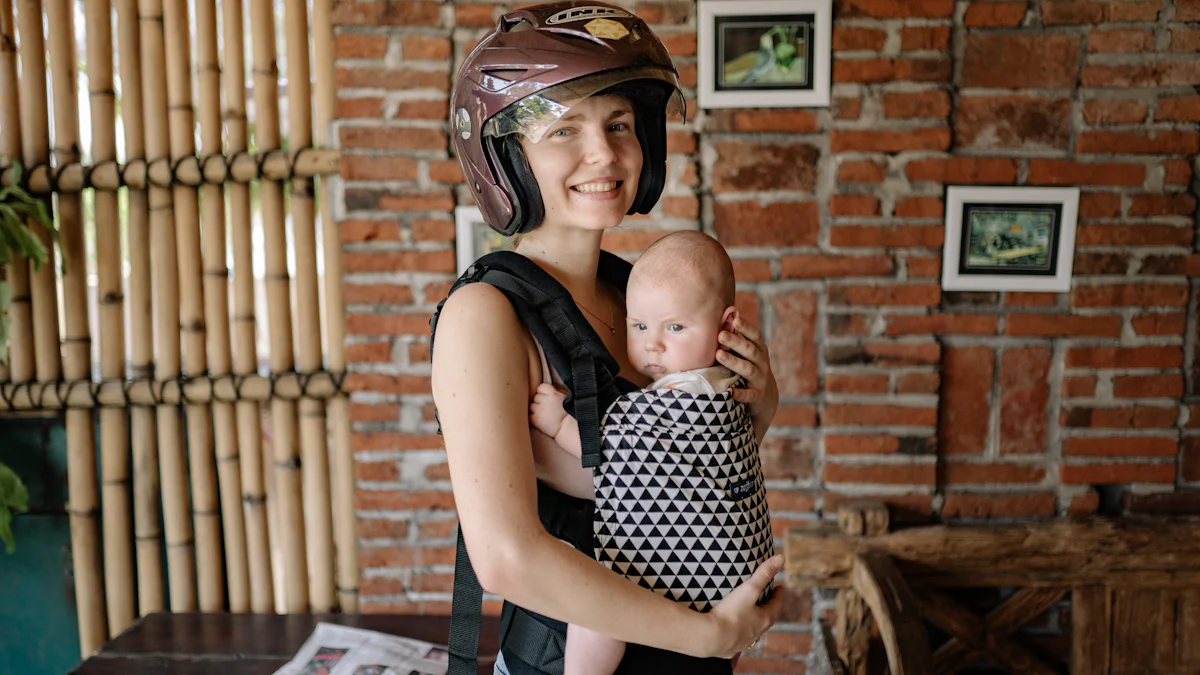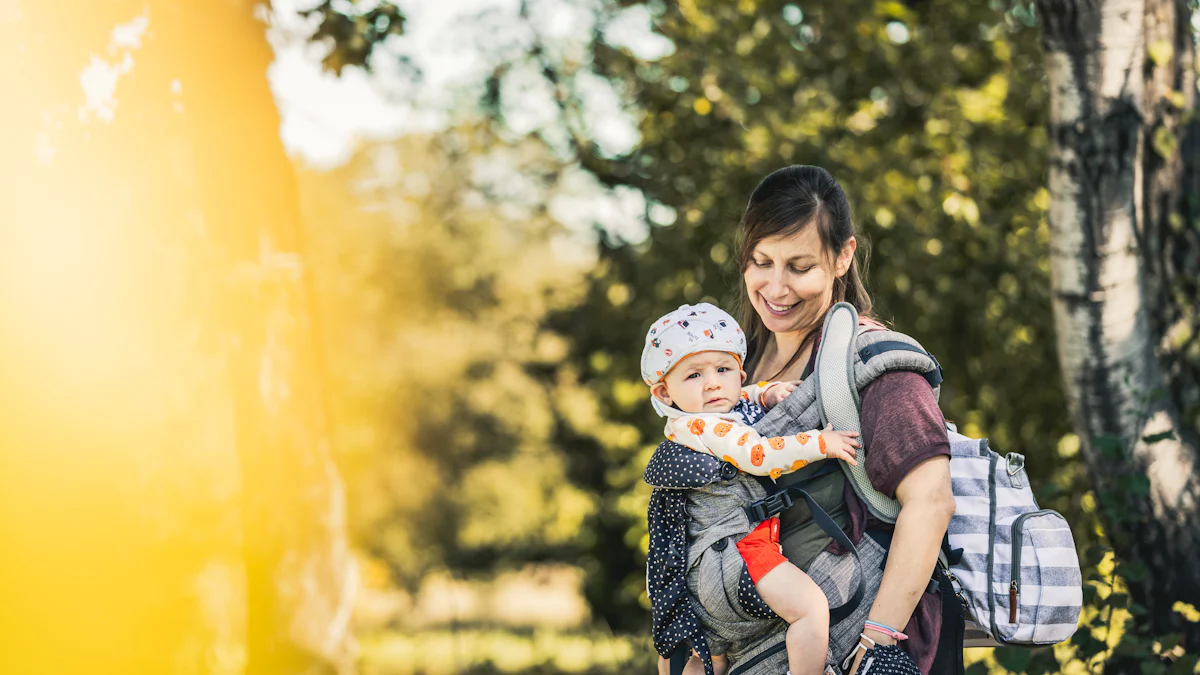

Parents often seek tools that simplify daily life while fostering a strong connection with their baby. A baby carrier offers a practical solution, allowing caregivers to keep their hands free while staying close to their child. This essential item promotes bonding and supports healthy development by keeping the baby secure and comfortable. Choosing the right carrier ensures both parent and baby experience maximum comfort during use. By prioritizing safety and fit, parents can confidently incorporate this tool into their routine, enhancing convenience and creating cherished moments.
Key Takeaways
- Pick a baby carrier that fits your daily needs. Use structured carriers for long trips and wraps for short tasks.
- Focus on safety features like adjustable straps and airy fabrics. These keep your baby comfy and lower risks.
- Place your baby in the carrier correctly. The ‘M’ shape helps hips grow well and avoids harm.
- Check the carrier often for damage. Look at straps and buckles to keep it safe and working.
- Adjust the carrier to fit your body. A good fit spreads weight evenly, easing back pain and adding comfort.
- Take breaks if using the carrier for a long time. Let your baby stretch and move to stay comfy and improve blood flow.
- Clean and store the carrier as directed. This keeps it in good shape and safe to use longer.
- Watch your baby for signs of being uncomfortable. If they seem fussy or too warm, stop and fix their position.
Choosing the Right Baby Carrier


Selecting the perfect baby carrier can feel overwhelming with so many options available. Understanding the different types and features ensures parents make an informed choice that suits their needs and lifestyle.
Types of Baby Carriers
Parents can choose from several types of baby carriers, each offering unique benefits. The table below highlights the most popular options:
| Type of Baby Carrier | Description |
|---|---|
| Structured baby carriers | Padded shoulder straps and waist belt, worn on front or back, suitable for various ages. |
| Baby wrap carriers | Long pieces of cloth wrapped around the torso, available in stretchy or woven options. |
| Baby ring slings | Shorter woven fabric worn over one shoulder, adjustable with metal rings for easy use. |
| Hybrid baby carriers | Combines features of structured and wrap carriers for adjustability and ease of use. |
| Baby hip carriers | Supports baby on the hip with a cushioned seat, designed for caregiver comfort. |
| Frame backpack carriers | Rigid frame carriers for hiking, worn on the back with extra storage and ventilation. |
Each type caters to different preferences. For example, structured carriers provide excellent support for long outings, while wraps and slings offer a snug, close-to-body feel for newborns.
Features to Consider
When choosing a baby carrier, parents should prioritize safety, comfort, and convenience. Carriers with recognized safety credentials undergo rigorous testing to meet high standards, reducing risks during use. Key features to look for include:
- Adjustable Straps and Buckles: These ensure a secure fit for both the parent and baby. Padded straps help distribute weight evenly, preventing discomfort during extended wear.
- Breathable and Durable Materials: Lightweight, breathable fabrics keep the baby cool, while durable materials ensure the carrier lasts through multiple stages of growth.
- Weight and Age Limits: Always check the manufacturer’s guidelines to ensure the carrier supports the baby’s current weight and age.
Parents often emphasize comfort when selecting a carrier. Wide seats and ergonomic designs promote proper hip positioning for the baby, while padded straps alleviate strain on the wearer’s back and shoulders.
Finding the Best Fit
A well-fitted baby carrier enhances comfort and usability. Parents should consider the following tips to find the best match:
Matching Carrier Size to Body Type
Not all carriers fit every body type. Adjustable models accommodate different sizes, making them ideal for families where multiple caregivers will use the carrier.
Testing Before Buying
Whenever possible, parents should try on carriers before purchasing. Many stores offer demonstration models, allowing caregivers to assess comfort and ease of use.
Considering Lifestyle and Daily Activities
Lifestyle plays a significant role in choosing the right carrier. Active parents may prefer structured or hybrid carriers for outdoor activities, while wraps or slings work well for quick errands or at-home use.
By carefully evaluating these factors, parents can select a baby carrier that meets their needs while ensuring their baby’s safety and comfort.

Safety Tips for Using a Baby Carrier
Ensuring safety while using a baby carrier is essential for both the parent and the child. Proper positioning, adherence to weight and age guidelines, and avoiding common mistakes can significantly reduce risks and enhance the babywearing experience.
Ensuring Proper Positioning
Correct positioning in a baby carrier prevents injuries and promotes healthy development. Parents should focus on two critical aspects:
Supporting Baby’s Hips in the “M” Position
The “M” position ensures the baby’s knees are higher than their hips, forming a natural squat. This posture supports healthy hip development and reduces the risk of hip dysplasia. According to the International Hip Dysplasia Institute (IHDI), improper leg positioning can lead to hip issues. Carriers with wide, ergonomic seats help maintain this position, making them a safer choice.
Keeping Baby’s Airway Clear
A clear airway is vital for the baby’s safety. Babies should always face inward with their chin off their chest to avoid airway obstruction. The Consumer Product Safety Commission (CPSC) has linked 14 infant suffocation deaths to sling-style carriers. Parents must ensure the baby’s face remains visible and close enough to kiss. Avoid placing the baby in a “C-shape” position, as it can restrict breathing.
| Risk Type | Evidence |
|---|---|
| Falls | 7.7% of injuries among infants were related to carriers, often resulting in serious injuries. |
| Suffocation | 14 infant suffocation deaths linked to sling-style carriers identified by CPSC. |
| Hip Dysplasia | Evidence from IHDI indicates improper leg positioning can lead to hip dysplasia. |
Following Weight and Age Guidelines
Baby carriers are designed for specific weight and age ranges. Following these guidelines ensures the carrier provides adequate support.
Adhering to Manufacturer Recommendations
Manufacturers provide weight and age limits for each carrier. Parents should always check these guidelines before use. For example, wraps and slings are ideal for newborns weighing 7-15 lbs, while structured carriers work well for toddlers up to 33 lbs. Using a carrier outside its recommended range can compromise safety.
| Age and Stage | Weight Range | Appropriate Carrying Positions | Suitable Carrier Types |
|---|---|---|---|
| Newborn or premature | 7 lbs and under | Speak to a babywearing consultant or educator | N/A |
| Infant Stage (0-6 months) | 7-15 lbs | Front inward facing, heart to heart | Wraps, Slings, Soft-Structured Carriers |
| Baby Stage (6-12 months) | 15-25 lbs | Front, inward or outward facing, side or back carrying | Slings, Soft-Structured Carriers |
| Toddler Stage (12 months+) | 25-33 lbs | Any position | Structured Carriers, Backpack Carriers |
Transitioning to a New Carrier as Baby Grows
As babies grow, their needs change. Parents should transition to a carrier that accommodates their child’s new weight and developmental stage. For instance, a structured carrier with back-carrying options may be more suitable for toddlers.
Avoiding Common Safety Mistakes
Even experienced parents can make mistakes when using a baby carrier. Awareness of these errors can prevent accidents.
Checking for Over-tightened or Loose Straps
Straps that are too tight can restrict the baby’s breathing, while loose straps increase the risk of falls. Parents should adjust the carrier to ensure a snug but comfortable fit. Regularly check buckles, straps, and zippers for functionality.
Inspecting for Wear and Tear
Worn-out carriers can compromise safety. Parents should inspect their carrier for frayed fabric, broken buckles, or other signs of damage. Replacing a damaged carrier promptly ensures continued safety.
Tip: Always follow the carrier’s instructions to avoid serious injuries. Proper use and regular maintenance can make babywearing a safe and enjoyable experience.
By prioritizing safety, parents can confidently use a baby carrier to keep their child secure while enjoying the convenience it offers.
Comfort for Both Parent and Baby


Ergonomics for Parents
Distributing Weight Evenly
Carrying a baby for extended periods can strain the body if the weight isn’t distributed properly. Parents should select carriers designed to spread the baby’s weight evenly across their shoulders, back, and hips. Structured carriers with padded shoulder straps and wide waistbands provide excellent support. These features reduce pressure points and prevent discomfort during long outings. Additionally, inward-facing carrying positions help balance the baby’s weight, making it easier to maintain proper posture.
Adjusting Straps to Prevent Back Pain
Back pain is a common concern for parents using a baby carrier. Proper adjustments can significantly reduce this issue. Parents should ensure the waistband sits snugly at their natural waist, not their hips, to support the lower back. Carriers with lumbar support offer extra stability, especially for those prone to back strain. Avoiding the hip carry position also prevents uneven weight distribution. Lastly, padded shoulder straps should be adjusted to keep the baby close to the body, minimizing strain on the back and shoulders.
Tip: Regularly check the fit of the carrier as your baby grows. A well-fitted carrier not only enhances comfort but also prevents long-term discomfort.
Ensuring Baby’s Comfort
Supporting Baby’s Head and Neck
A baby’s head and neck require adequate support, especially during the early months. Carriers with built-in headrests or adjustable panels provide the necessary stability for newborns. For infants who cannot hold their heads up, parents should ensure the carrier keeps the baby’s head aligned with their spine. This positioning prevents strain and promotes healthy development.
Preventing Overheating
Babies are sensitive to temperature changes, making it crucial to prevent overheating while using a carrier. Breathable fabrics, such as cotton or mesh, allow air circulation and keep the baby cool. Parents should dress their baby in lightweight clothing and monitor for signs of overheating, such as flushed skin or fussiness. During warmer months, carriers with ventilation panels can enhance airflow and keep both parent and baby comfortable.
Note: Always check the baby’s temperature by feeling their neck or back. Adjust clothing or carrier settings as needed to maintain a comfortable environment.

Adjusting for Long-Term Use
Switching Carrying Positions as Baby Grows
As babies grow, their needs and preferences change. Parents should transition between carrying positions to accommodate these changes. For newborns, front inward-facing positions provide security and closeness. As the baby gains head and neck control, outward-facing or hip-carrying positions allow them to explore their surroundings. For toddlers, back-carrying positions offer better support and freedom of movement for the parent.
Taking Breaks to Avoid Fatigue
Even with the most ergonomic carrier, prolonged use can lead to fatigue. Parents should take regular breaks to rest their muscles and prevent overexertion. Alternating between carrying and using a stroller can help reduce strain. Additionally, short breaks allow the baby to stretch and move, promoting circulation and comfort.
Reminder: Listen to your body. If you feel discomfort or fatigue, adjust the carrier or take a break to avoid long-term strain.
By prioritizing ergonomics and comfort, parents can enjoy the benefits of babywearing while ensuring a positive experience for both themselves and their child.
Practical Tips for Everyday Use
Cleaning and Maintenance
Washing Instructions for Different Materials
Proper cleaning ensures a baby carrier remains safe and comfortable for your child. Different materials require specific care to maintain their quality. For example, cotton carriers can often be machine-washed on a gentle cycle, while delicate fabrics like linen or silk may need handwashing. Always check the manufacturer’s instructions before cleaning. Spot cleaning is ideal for small stains, but ensure all soap is thoroughly rinsed out to avoid skin irritation. After washing, air drying is recommended to prevent shrinkage or damage caused by high heat.
Tip: Avoid using harsh detergents or bleach, as these can weaken the fabric and compromise the carrier’s durability.
Proper Storage to Maintain Quality
Storing a baby carrier correctly extends its lifespan. Follow these best practices to keep your carrier in top condition:
- Read the manual for specific storage instructions.
- Clean the carrier regularly and ensure it is completely dry before storing.
- Fold the carrier neatly and store it in a cool, dry place away from direct sunlight.
- Use a storage bag or box to protect it from dust and moisture.
Regular maintenance and proper storage ensure the carrier remains safe and ready for use whenever needed.
Multitasking with a Baby Carrier
Using a Carrier While Doing Chores
A baby carrier allows parents to tackle household tasks while keeping their baby close. Whether folding laundry, preparing meals, or tidying up, a carrier frees up your hands and keeps your baby content. Structured carriers with padded straps provide the support needed for extended wear, making multitasking more comfortable. Always ensure the baby is securely positioned and their airway remains unobstructed during activities.
Reminder: Avoid using a carrier near hot surfaces or sharp objects to ensure your baby’s safety.
Traveling with a Baby Carrier
Traveling becomes more manageable with the right baby carrier. Soft-structured carriers with adjustable straps and padded buckles are ideal for long outings. For newborns, wraps or slings offer gentle support, while carrier backpacks work well for older babies and toddlers. Look for breathable fabrics like cotton or linen to keep both you and your baby cool during travel. Ensure the carrier promotes healthy hip development by maintaining the “M” position, and always check that your baby’s airway is clear.
Tip: Choose a carrier recognized by the International Hip Dysplasia Institute for added peace of mind.

Recognizing When Not to Use a Baby Carrier
Avoiding Use During Certain Activities
While baby carriers are versatile, some activities are unsafe for babywearing. Avoid using a carrier during high-impact exercises, cycling, or cooking near open flames. These activities pose risks to both the parent and the baby. Instead, opt for a stroller or playpen when engaging in such tasks.
Identifying When Baby Needs a Break
Babies can become restless or uncomfortable after extended periods in a carrier. Watch for signs like fussiness, squirming, or flushed skin, which may indicate overheating or discomfort. Taking regular breaks allows your baby to stretch and move freely, promoting circulation and overall well-being.
Note: Always prioritize your baby’s comfort and safety by monitoring their behavior and adjusting as needed.
By following these practical tips, parents can maximize the benefits of their baby carrier while ensuring a safe and enjoyable experience for both themselves and their child.
A baby carrier simplifies parenting by offering convenience, fostering bonding, and supporting a baby’s healthy development. Parents should prioritize safety by ensuring proper neck and hip support, especially for newborns. Choosing a carrier with breathable fabrics and ergonomic designs enhances comfort for both parent and baby. Practicality also matters—selecting a carrier that suits daily activities can make life easier. By following these tips, parents can confidently embrace babywearing, creating cherished moments while maintaining mobility and comfort.
Reminder: Always check the manufacturer’s guidelines for weight and age limits to ensure the carrier’s suitability.
FAQ
What is the best baby carrier for newborns?
Wraps and slings are ideal for newborns. They provide a snug fit and support the baby’s head and neck. Parents should choose carriers made from soft, breathable fabrics to ensure comfort and safety during the early months.
How long can a baby stay in a carrier?
Babies can stay in a carrier for 1-2 hours at a time. Parents should monitor for signs of discomfort or overheating. Taking breaks allows the baby to stretch and move, promoting circulation and overall well-being.
Can baby carriers cause hip problems?
Improper positioning can lead to hip issues. Carriers that support the “M” position, where the knees are higher than the hips, promote healthy hip development. Parents should always check the carrier’s design and adjust it for proper alignment.
Are baby carriers safe for preemies?
Parents of premature babies should consult a pediatrician before using a carrier. Specialized carriers designed for preemies offer additional support. Ensuring proper positioning and monitoring the baby’s airway are critical for safety.

How do I clean my baby carrier?
Follow the manufacturer’s instructions for cleaning. Most cotton carriers are machine-washable, while delicate fabrics may require handwashing. Spot cleaning works for minor stains. Air drying preserves the carrier’s quality and prevents shrinkage.
Can I breastfeed while using a baby carrier?
Yes, many carriers allow discreet breastfeeding. Parents should adjust the carrier to lower the baby to a comfortable position. After feeding, reposition the baby to ensure their airway remains clear and supported.
What should I do if my baby dislikes the carrier?
Introduce the carrier gradually. Start with short sessions and ensure the baby is well-fed and rested. Adjust the fit for comfort and try different carrying positions. Some babies need time to adapt to the sensation of being carried.
Are baby carriers suitable for hot weather?
Carriers made from lightweight, breathable fabrics like cotton or mesh are best for warm climates. Parents should dress their baby in light clothing and monitor for signs of overheating, such as fussiness or flushed skin.
Tip: Always prioritize your baby’s safety and comfort by choosing a carrier that meets their developmental needs and your lifestyle.
